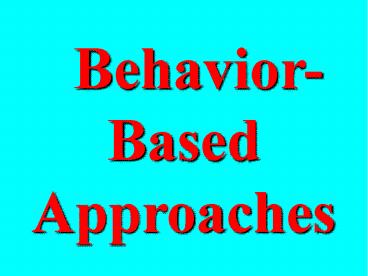Behavior-Based Approaches - PowerPoint PPT Presentation
Title:
Behavior-Based Approaches
Description:
Behavior-Based Approaches Overview Sonar Sound Navigation and Ranging Sonar provides useful information about objects very close to the robot and is often used for ... – PowerPoint PPT presentation
Number of Views:132
Avg rating:3.0/5.0
Title: Behavior-Based Approaches
1
Behavior-Based Approaches
2
Finishing up robotic architecture
Reactive control Motor Schemas
Subsumption
3
Overview
Robot architecture from the bottom up Getting
around
Perceiving the world
4
Overview
Reasoning
representing space motion planning
5
Overview
Handling uncertainty
sensor fusion building maps localization
6
Overview
Vision -- just another sensor ?
7
Overview
- Sonar Sound Navigation and Ranging
- Sonar provides useful information about objects
very close to the robot and is often used for
fast emergency collision avoidance. - Camera data
- machine vision
- structured light sensors
- cross beam sensors
- parallel-beam sensors
8
ARCHITECTURES
- How the job of generating actions from percepts
is organized - Concerned to Autonomous mobile robot in dynamic
environments - The design of robot architectures is essentially
the same agent design problem that was discussed
9
Classical architecture
- Shakey 1969, demonstrated the importance of
experimental research in bringing to light
unsuspected difficulties - difficulties of general problem solving
- integrating geometric and symbolic representation
of the world - low level actions
- macro-operators
- error detection
- recovery capabilities
10
Situated automata
- Since the mid 1980s , a significant minority of
AI and robotics researchers have begun to
question the classical view of intelligent
agent design based on representation and
manipulation of explicit knowledge - In robotics, the principal drawback of the
classical view is that explicit reasoning about
the effects of low-level actions is too expensive
to generate real time behavior
11
Situated automata
- Finite state machine whose inputs are provided
by sensors connected to the environment and whose
outputs are connected to effectors - Situated automata provide a very efficient
implementation of reflex agents with state
12
Rosenscheins basic design
- Theorem
- Any finite-state machine can be implemented as a
state register together with a feed-forward
circuit that updates the state based on the
sensor inputs and the current state, and another
circuit that calculates the output given the
state register - Execution time for each decision cycle is small
13
(No Transcript)
14
CONFIGURATION SPACES A FRAMEWORK FOR ANALYSIS
- Both the configuration of the robots body and
the locations of the objects in physical space
are defined by real-valued coordinates. - It is therefore impossible to apply standard
search algorithms in any straightforward way
because the number of states and actions are
infinite. - The configuration space is mathematical tool for
design and analyzing motion planning algorithms.
15
Robot Architectures
how much / how do we represent the world
internally ?
None.
Absolute Control
Just the current world.
Purely Reactive Control
Subsumption paradigm
Just what we need.
Motor Schema
As much as possible.
SPA architecture
16
Robot Architectures
how much / how do we represent the world
internally ?
Just the current world.
Purely Reactive Control
- Decision-making based only on the current sensor
readings.
- For the survivor robot assignment (A, part 1)
- int computeRotationalVelocity()
17
One view of reactive control
Control is a function of the sensed data.
- Look at the front nine sonar values -- which are
closest ?
Case 1 If sonars 12, 13, or 14
Turn left at 20 deg./sec
Case 2 If sonars 15, 0, or 1
Turn left at 40 deg./sec
Case 3 If sonars 2, 3, or 4
Turn right at 20 deg./sec
0
18
Another view of reactive control
Direct mapping from the environment to a control
signal
goal-seeking behavior
obstacle-avoiding behavior
19
Robot Architecture
how much / how do we represent the world
internally ?
Motor Schema
Just what we need.
Subsumption paradigm
- Motor schemas compose simple reactions by adding
the outputs that each would send to the robot. - Individual schemas may contain state
Ron Arkin _at_ Georgia Tech
20
Behavior Summer
path taken by a robot controlled by the resulting
field
vector sum of the avoid and goal motor schemas
21
Additional primitives
Direct mapping from the environment to a control
signal
go! schema
corridor-centering schema
22
A more complex task
Direct mapping from the environment to a control
signal
larger composite task
23
Another primitive
Direct mapping from the environment to a control
signal
larger composite task
random motion schema
24
Local minima
Noise allows a system to jump out of local
minima.
the problem
a solution
25
Bigger deadends...
How to get out of larger wells ?
26
Bigger deadends...
uses memory of where the robot has been
past-avoiding motor schema
27
Another example
Keeping away from past locations...
28
Inspiration
29
Inspiration
Study of how animals react to different stimuli
Rodents (Hull 1934)
Toads (Arbib 87)
Vowels
30
Beyond subsumption
Navlab ALVINN
Polly
...
...
1995
31
Polly
Ian Horswill _at_ MIT

